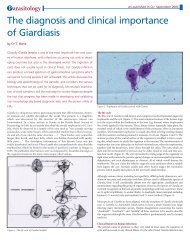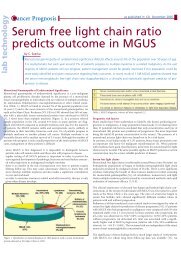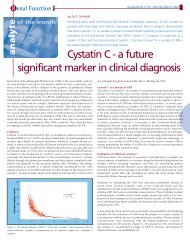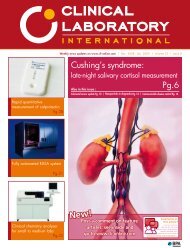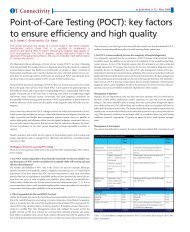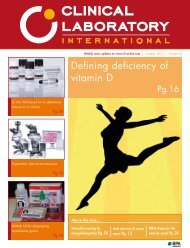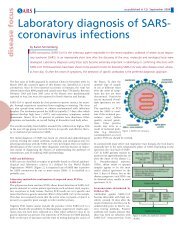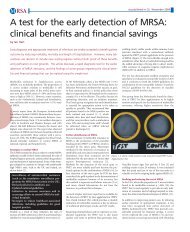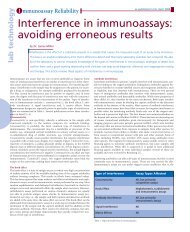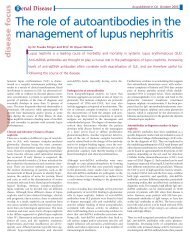Screening for cancer: are biomarkers of value?
Screening for cancer: are biomarkers of value?
Screening for cancer: are biomarkers of value?
Create successful ePaper yourself
Turn your PDF publications into a flip-book with our unique Google optimized e-Paper software.
– February/March 2011 8 Tumour markers<br />
a 5-year survival rate <strong>of</strong> >90% can be<br />
achieved when disease is confined to the<br />
ovary. Un<strong>for</strong>tunately, only about 25% <strong>of</strong><br />
ovarian <strong>cancer</strong>s <strong>are</strong> detected at this early<br />
stage. This correlation between 5-year survival<br />
rates and stage at diagnosis suggests<br />
that screening and early detection may<br />
improve outcome.<br />
Because <strong>of</strong> its relatively low prevalence, a<br />
screening strategy <strong>for</strong> ovarian <strong>cancer</strong> must<br />
have an extremely high specificity to minimise<br />
the number <strong>of</strong> false-positive results.<br />
Based on a prevalence <strong>of</strong> 40 cases per<br />
100,000 women, it has been estimated that<br />
in order to achieve an acceptable positive<br />
predictive <strong>value</strong> (at least 10%), an ovarian<br />
<strong>cancer</strong> screening strategy should have a<br />
specificity <strong>of</strong> 99.6% [14].<br />
The main screening tests undergoing evaluation<br />
<strong>for</strong> ovarian <strong>cancer</strong> <strong>are</strong> CA 125 and<br />
transvaginal ultrasound (TVS). Currently,<br />
two large prospective trials <strong>are</strong> evaluating<br />
these modalities in screening healthy<br />
women <strong>for</strong> ovarian <strong>cancer</strong>, namely the<br />
PLCO study in the US [15] and the United<br />
Kingdom Collaborative Trial <strong>of</strong> Ovarian<br />
Cancer <strong>Screening</strong> (UKCTOCS) [16].<br />
Preliminary results from the UK trial <strong>are</strong><br />
promising. Thus, <strong>of</strong> the 58 <strong>cancer</strong>s detected<br />
with CA 125 and TVS, 28 (48%) were<br />
found to be either stage I or II. Sensitivity,<br />
specificity and PPV <strong>of</strong> the two tests <strong>for</strong><br />
primary and tubal malignancies combined<br />
were respectively 89.4%, 99.8% and 35.1%.<br />
Currently, it is unclear whether screening<br />
with CA 125 and TVS reduces mortality<br />
from ovarian <strong>cancer</strong> [16]. Guidelines<br />
there<strong>for</strong>e recommend against the use <strong>of</strong><br />
CA 125 either alone or in combination<br />
with TVS in screening <strong>for</strong> ovarian <strong>cancer</strong><br />
in asymptomatic average-risk women outside<br />
the context <strong>of</strong> a randomised controlled<br />
trial [6,17].<br />
HCG in screening <strong>for</strong> gestational<br />
tropohoblastic neoplasia<br />
Gestational trophoblastic neoplasia (GTN)<br />
is a r<strong>are</strong> malignancy that originates from<br />
placental tissue. Although most GTNs<br />
develop following a molar pregnancy, they<br />
can occur after any antecedent pregnancy.<br />
As previously pointed out [3,18], the use <strong>of</strong><br />
human chorionic gonadotropin (HCG) to<br />
screen <strong>for</strong> GTN in patients diagnosed with<br />
a hydatidi<strong>for</strong>m mole approaches the ideal<br />
use <strong>of</strong> a screening biomarker as:<br />
• HCG levels <strong>are</strong> increased in almost all<br />
patients with trophoblastic disease,<br />
• HCG is a highly sensitive marker <strong>for</strong><br />
small volume trophoblastic disease,<br />
• The prevalence <strong>of</strong> malignant trophoblastic<br />
disease in women diagnosed with a previous<br />
hydatidi<strong>for</strong>m mole is relatively high<br />
(3 to 15%) and<br />
• Effective chemotherapy is available <strong>for</strong><br />
malignant trophoblastic disease.<br />
The combination <strong>of</strong> HCG measurements,<br />
organised follow-up and availability <strong>of</strong><br />
effective chemotherapy means that GTN<br />
is one <strong>of</strong> a few human malignancies that is<br />
curable, even in advanced stages <strong>of</strong> the disease.<br />
Indeed, cure rates <strong>for</strong> this malignancy<br />
now approach 100%. An important practical<br />
point in measuring HCG in GTN is that the<br />
assay used should detect all the main <strong>for</strong>ms<br />
<strong>of</strong> the protein, especially the beta subunit.<br />
Conclusion<br />
Although the measurement <strong>of</strong> <strong>biomarkers</strong><br />
has great appeal <strong>for</strong> <strong>cancer</strong> screening,<br />
their use to date has been disappointing<br />
from the point <strong>of</strong> view <strong>of</strong> reducing mortality<br />
from <strong>cancer</strong>, especially in asymptomatic<br />
populations. Their main utility in screening<br />
is likely to be in high-risk populations,<br />
where the prevalence <strong>of</strong> <strong>cancer</strong> is high. A<br />
good example <strong>of</strong> this is the use <strong>of</strong> HCG in<br />
screening <strong>for</strong> GTN in patients who had a<br />
previous diagnosis <strong>of</strong> a hydatidi<strong>for</strong>m mole.<br />
References<br />
1. Duffy MJ. J Int Fed Clin Chem Lab Med (JIFCC)<br />
2010;21:issue 1.<br />
2. Zhang B-H, Yang B-H, Tang ZY. J Cancer Clin<br />
Oncol 2004;130:417-422.<br />
3. Sturgeon C. A wide role <strong>for</strong> tumour markers in<br />
screening. Clin Lab Int April 2006.<br />
4. Schröder FH, Hugosson J, Roobol MJ, et al. N Engl J<br />
Med 2009;26;360:1320-8.<br />
5. Andriole GL, Craw<strong>for</strong>d ED, Grubb RL 3rd, et al. N<br />
Engl J Med 2009;360:1310-9.<br />
6. Sturgeon CM, Duffy MJ, Stenman UK et al. Clin<br />
Chem 2008;54:e11-79.<br />
7. Hewitson P, Glasziou P, Irwig L, Towler B, Watson<br />
E. Cochrane Database <strong>of</strong> Systematic Reviews 2007,<br />
Issue 1, Art. No.: CD001216. DOI: 10.1002/14651858.<br />
CD001216.pub2.<br />
8. Duffy MJ, van Rossum LG, van Turenhout ST et al.<br />
Int J Cancer 2011;128:3-11.<br />
9. Parikh S, Hyman D. Am J Med 2007;120:194-202.<br />
10. Sturgeon CM, Duffy MJ, H<strong>of</strong>mann BR et al. Clin<br />
Chem 2010;56:e1-48.<br />
11. National Comprehensive Cancer Network<br />
(NCCN) Clinical Practice Guidelines in Oncology,<br />
Hepatobiliary Cancers Version 2. 2010. http://<br />
www.nccn.org/ (Accessed, 27 Jan, 2011).<br />
12. Bruix J, Sherman M. Hepatology 2005;42:1208-36.<br />
13. Clarke-Pearson DL. N Engl J Med 2009;361:170-176.<br />
14. Jacobs I, Bast RC. Human Reprod 1989;4:1-12.<br />
15. Buys SS, Partridge E, Greene MH et al. Am J Obstet<br />
Gynecol 2005;193:1630-1639.<br />
16. Menon U, Gentry-Maharaj A, Hallett R et al. Lancet<br />
Oncol 2009;10:327-40.<br />
17. Duffy MJ, Bonfrer JM, Kulpa J et al. Int J Gynecol<br />
Cancer 2005;15:679-691.<br />
18. Duffy MJ. Crit Rev Clin Lab Sci 2001;38:225-262.<br />
The author<br />
Michael J Duffy<br />
Dept <strong>of</strong> Pathology and Laboratory<br />
Medicine<br />
St Vincent’s University Hospital, Dublin 4,<br />
UCD School <strong>of</strong> Medicine and Medical Science,<br />
University College Dublin, Dublin 4, Ireland.<br />
Corresponding address:<br />
Pr<strong>of</strong>essor M J Duffy<br />
Dept <strong>of</strong> Pathology and Laboratory<br />
Medicine<br />
St Vincent’s University Hospital<br />
Elm Park, Dublin 4, Ireland.<br />
Tel. +353-1-2094378<br />
e-mail: michael.j.duffy@ucd.ie<br />
BioVitrum and Sakura Finetek<br />
Europe selected to modernise<br />
Russian oncology<br />
Over the period<br />
2009 to 2013 the<br />
Russian government<br />
is providing<br />
the Russian<br />
national Health<br />
Programme with a<br />
special budget <strong>of</strong> approximately e11 billion<br />
to be used in programmes aimed at<br />
modernising the country’s <strong>cancer</strong> healthc<strong>are</strong><br />
system. The main programme is split<br />
into different sub-programmes covering<br />
specific medical <strong>are</strong>as, such as <strong>cancer</strong><br />
research and oncology, with one aim<br />
<strong>of</strong> the sub-programmes being to equip<br />
a certain number <strong>of</strong> hospitals each year<br />
with the latest technology.<br />
Since 2009, BioVitrum, Sakura Finetek<br />
Europe’s exclusive distributor in Russia<br />
and the <strong>for</strong>mer CIS countries, has been<br />
granted over 70% <strong>of</strong> all issued public tenders<br />
in the oncology sub-programme and<br />
has modernised 14 hospitals nationwide<br />
through the installation <strong>of</strong> high-per<strong>for</strong>mance<br />
Tissue-Tek instruments. These hospitals<br />
<strong>are</strong> now providing excellent patient<br />
c<strong>are</strong> such as the reduction <strong>of</strong> both <strong>cancer</strong><br />
waiting times and misdiagnosis rates;<br />
this is achieved through the provision<br />
<strong>of</strong> a superior laboratory environment<br />
equipped with highly reliable and innovative<br />
instruments that improve the quality<br />
and efficiency <strong>of</strong> <strong>cancer</strong> diagnosis and<br />
treatment. As a result, patients <strong>are</strong> now<br />
able to get their diagnosis within one day.<br />
www.smartautomation.eu



